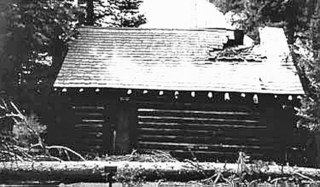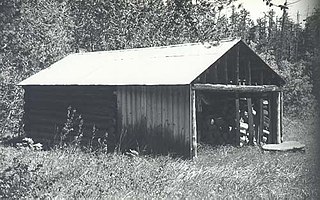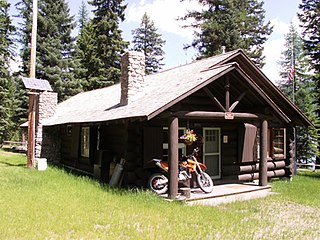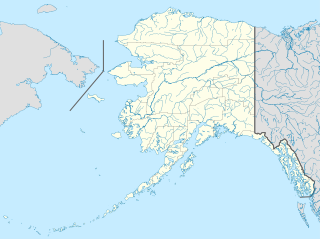
The Cascade Canyon Barn was designed by the National Park Service to standard plans and built by the Civilian Conservation Corps in 1935. The National Park Service rustic style barn is 5 miles (8 km) west of Jenny Lake in Grand Teton National Park in the U.S. state of Wyoming.

The Death Canyon Barn is a combination barn and ranger patrol cabin in Grand Teton National Park. The barn was built in Death Canyon on the Death Canyon Trail at its junction with the Alaska Basin Trail by the Civilian Conservation Corps in 1935 in the National Park Service rustic style. Located with a clear view of Prospector Mountain, it shares a common style and purpose with the Cascade Canyon Barn to the north in the park, with minor differences attributable to available materials and the preferences of the work crews building the barns.

The Moran Bay Patrol Cabin was built by the Civilian Conservation Corps about 1932. The log structure was located in the northern backcountry of Grand Teton National Park, and was built to a standard design for such structures, in the National Park Service Rustic style, but for the U.S. Forest Service, which administered much of the area prior to the expansion of the park in 1943. The Upper Granite Canyon Patrol Cabin is similar.

The Squirrel Meadow Guard Station is a ranger station in the backcountry of Targhee National Forest in Wyoming. The original facility was established in 1907, with the present structures built in 1934. The log cabin station is an example of a standard US Forest Service backcountry patrol structure.

The Logging Creek Ranger Station is the oldest continually operating administrative site in Glacier National Park. The rustic log cabin is an early example of what would become a typical style of western park structure. The district includes a cabin used as a residence for the summer fire guard.

The Lee Creek Snowshoe Cabin was built in Glacier National Park in 1925–27 by Austin Swikert as a shelter for winter hikers. The log structure consists of a single room with wood floor, unfinished walls and roof. A trap door in the floor provides access to a small cellar food cache. There is a woodstove with metal chimney.

The Kootenai Creek Snowshoe Cabin was built in Glacier National Park in 1926. The rustic log structure comprises a single room with a woodstove, and a small cellar food cache. The cabin was situated on the patrol route from the Goat Haunt ranger station to the Fifty Mountain-Flattop region, about eight miles upstream from the ranger station. Unlike most patrol cabins, it is isolated from the park's main trail routes.

The Kintla Lake Ranger Station in Glacier National Park is a rustic log structure that was built by the Butte Oil Company in 1900 at Kintla Lake. It was taken over by the National Park Service and used as a ranger station. It is significant as a remnant of early oil exploration activities in the Glacier area. A boathouse was built by the National Park Service in 1935 to the same design as the boathouses at Upper Lake McDonald and Saint Mary ranger stations. A fire cache cabin, identical to those at Logging Creek, Polebridge and Lake McDonald ranger stations was built in 1934.

The Nyack Ranger Station Historic District encompasses the remnants of the former ranger station. Only two buildings now remain: the barn, built in 1935 from plans by the National Park Service Branch of Plans and Design, and the fire cache cabin, built by Austin Weikert in 1935.

The Skyland Camp-Bowman Lake Ranger Station in Glacier National Park was originally built as the Culver Boys' Military Academy. The main building, known variously as the Skyland Camp Messhall, Culver Boys' Military Academy Messhall and Skyline Chalet, was built in 1920 and is a good example of National Park Service Rustic architecture. The main cabin, known as "Rainbow Lodge" was built by the boys of the academy in 1920 from red cedar logs, and is more elaborate and carefully detailed than typical ranger stations of this period. The interior is dominated by a stone fireplace.

The Lower Nyack Snowshoe Cabin, built in 1927 in Glacier National Park, is a significant resource both architecturally and historically as a shelter about one day's travel north of the Theodore Roosevelt Highway for patrolling backcountry rangers. The design originated at Yellowstone National Park, adapted in this case with a somewhat larger size.

The Upper Nyack Snowshoe Cabin, built in 1926 in Glacier National Park, is a significant resource both architecturally and historically as a shelter, usually 8–12 miles apart, for patrolling backcountry rangers. The design is similar to that used in Yellowstone National Park, which was in turn adapted from U.S. Forest Service shelters, which were themselves adaptations of trapper cabins. Upper Nyack retains some original interior furnishings, including hanging beds.

The Ford Creek Patrol Cabin in Glacier National Park was built in 1928. The National Park Service Rustic log structure was a significant resource both architecturally and historically as a network of shelters, approx. one day's travel apart, for patrolling backcountry rangers.

Upper Windy Creek Ranger Cabin No. 7, also known as the Upper Windy Patrol Cabin is a log shelter in the National Park Service Rustic style in Denali National Park. The cabin is part of a network of shelters for patrolling park rangers throughout the park. It is a standard design by the National Park Service Branch of Plans and Designs and was built in 1931.

The Cabin Creek Ranger Residence and Dormitory, also known as the Cabin Creek Ranger Station, were built in 1934 and 1935 in Sequoia National Park by the Civilian Conservation Corps. The three-room wood-frame residence and the two-room dormitory are examples of the National Park Service Rustic style.

The following articles relate to the history, geography, geology, flora, fauna, structures and recreation in Glacier National Park (U.S.), the U.S. portion of the Waterton-Glacier International Peace Park.

The Huckleberry Creek Patrol Cabin is located in the northern portion of Mount Rainier National Park, Washington, United States. It was built around 1934 to house rangers on patrol within the park. The log cabin's design resembles the "Standard Plan for Patrol Cabins" prepared by the Western Division of the National Park Service, with the addition of a full-width front porch. Civilian Conservation Corps labor may have been used in the construction of the cabin.

The Ewe Creek Ranger Cabin No. 8, also known as Lower Savage River Cabin and Lower Savage Patrol Cabin, is a historic backcountry shelter in Denali National Park and Preserve. It is located 5 miles (8.0 km) downstream (north) from the park highway, on the banks of the Savage River. It is fashioned from peeled logs, with the gaps filled with moss, oakum, and chinking. The gable roof is corrugated metal. The cabin is one of four built by the National Park Service in the park in 1931. The cabin is used by rangers who patrol the park's backcountry.

The Lower Windy Creek Ranger Cabin No. 15, also known as Lower Windy Creek Patrol Cabin and Lower Windy Shelter Cabin, is a historic backcountry shelter in the Denali National Park & Preserve, in Alaska. It is built out of peeled logs, sealed with oakum and concrete chinking. It has a medium-pitch gable roof of corrugated metal and shiplap. The site includes seven log shelters for dogs, located about 70 feet (21 m) north of the cabin. The cabin is located about 500 feet east of Mile 324 on the Alaska Railroad.

The Jack Creek Guard Station is a ranger patrol cabin in Medicine Bow National Forest in Carbon County, Wyoming. The one-room log cabin was built by U.S. Forest Service district ranger Evan John Williams in 1933-34. It was built to Forest Service Plan A-4, featuring half-dovetailed corners and a deep front porch with a gabled wood shake roof. A stove is vented through a brick chimney at the back of the cabin.




















